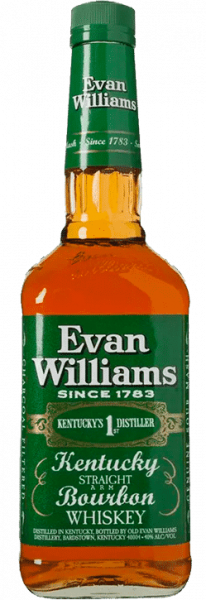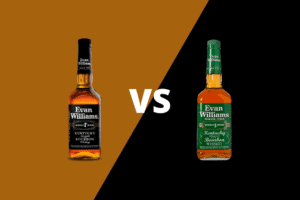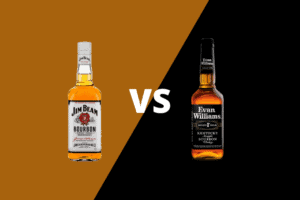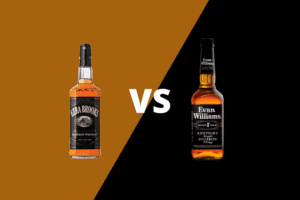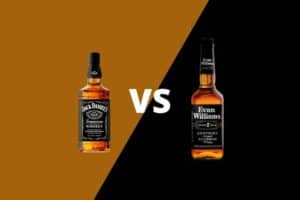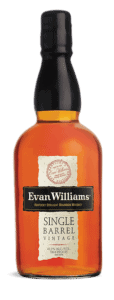Recently, I was asked to review Evan Williams Green Label – a brand extension of the more familiar Black Label product.
The only problem: I’ve never had it.
While researching this article, I came to find that not only is there limited information about the product online, but it’s also virtually impossible to find it in some markets – including my own.
So, what’s the deal?
To do it justice, we’re going to have to do some detective work. So, in this blog post, we’re going to examine Evan Williams Green Label to share as much information about this lesser-known product.
Overview
Evan Williams Green Label is a lower-proof version of the brand’s popular Black Label offering. It is similar in terms of flavor profile, but the main difference is that it is bottled at a lower proof — 80-proof, or 40 percent alcohol by volume, compared to Black Label, which is 86-proof or 43 percent ABV. Both products are labeled as Kentucky Straight Bourbon Whiskey.
Before we go further, let’s stress a few points.
First, I should note I am not associated with the brand and have not had input1 from Heaven Hill — the spirits producer that makes Evan Williams and a number of other well-known whiskey brands. Much of what is being written in this post is conjecture peppered with a liberal dose of assumption.
Hopefully, we can unknot a tricky and complicated subject matter in a way that budding whiskey fans and enthusiasts might find helpful.
First, let’s put this product into context.
Evan Williams Bourbon is the No. 2 selling Bourbon whiskey in the United States, behind Jim Beam. Its most popular offering — in terms of sales volume — is the ‘Black Label’ expression, whose price point is on the value segment’s upper edge. Its Green Label bottling allows the brand to offer a similar product but at a lower price.
Evan Williams Black Label costs about $15 per 750mL bottle and is bottled at 86-proof, or 43 percent alcohol by volume. Evan Williams Green Label costs about $10 for a 750mL bottle at 80-proof. By comparing the labels of Evan Williams black and green labels, it is hard to discern many differences other than the color of the label and the difference in proof.
All About Blending
Let’s talk about blending.
Every bottle of whiskey — except for single barrel offerings — contains a single ‘batch’ of whiskey barrels that are dumped together. It could be two or three barrels if it’s a small craft whisky brand, or it could be thousands of barrels if it’s the distillery of a major international brand.
This is true of nearly every whiskey type — single malts and blended scotch, single pot Irish whiskeys, Canadian blends, Japanese whiskies, American bourbon and rye whiskeys — you name it.
This may cause confusion for new whiskey drinkers trying to familiarize themselves with the nuances of whiskey sub-categories because Blended Whiskey is its own distinct style of whiskey as well.
We’ll try to unpack this term because it might offer valuable clues in our search for our green label product’s origins.
Blended whiskey is a catch-all term that describes the blending — or mixing together — of different types of whiskey.
In the world of whiskey, the Master Distiller has come to take on an almost mythical significance. This position describes the leader of the production team, who is often responsible for making decisions that affect the final flavor: mash bills, fermentation recipes, distillation techniques, etc. For many brands, the Master Distiller also acts as the brand’s public face and speaks to fans at events and is featured in multimedia campaigns.
But where distilling is a science heavily relying on chemistry, blending is an artform.
The Master Blender is the person in charge of choosing the barrels at most distilleries. While it may seem to be an easy task — just wait until the barrels reach a certain age and dump — the position is much more nuanced. The blender is tasked with making each batch of the brand consistent from year to year — whether it was bottled in 2001 or 2021 — using only the sense of taste and smell. When you consider changes in volume size, this is a challenging job that might mean blending hundreds of barrels — each with its own unique flavor — together for any given batch.
Origin of a Well Drink
It could be that the green label is the same batch blend as the black label, only segregated and further diluted before bottling. Or it could be that the green label is an entirely different blend – one that the Master Blender and blending team identify barrels for that have the specific characteristics for which they are looking.
What would those characteristics be?
Well, it could be that the blenders are trying to identify barrels with a lighter and mellower taste – something that would be clean and smooth in a cocktail, for example. The blend could be made of barrels in different locations in the warehouse – barrels that might not be right for the black label expression. Another option is that they use slightly younger barrels in order to offer the product at a lower price point.
We just can’t be sure without speaking to the production team.
Either way, it is likely the green label — at a lower price point and bottle proof — is a product made primarily or specifically for high-volume on-premise accounts. At about $10 per bottle, Evan Williams Green Label is a perfect candidate to be a ‘rail’ whiskey in a bar well.
If you’ve ever been to a bar or restaurant during happy hour, you’re likely familiar with the concept, even if you’ve never heard it by name. Rail spirits are high-volume, low-cost brands that often offer higher margins for bar managers. When you order a ‘whiskey and coke’ without specifying a brand, the bartender will likely reach for the bar’s rail product.
By offering a green label extension, bar managers can list a familiar name on their cocktail menus but offer them at lower prices with higher returns. The whiskey producer can also offer price-breaks to large accounts based on quantity. When you consider the amount of spending power a customer like an international hotel chain can have on the market, you can understand why offering a discounted price on volume might provide a valuable revenue stream to spirits brands.
Conclusion
The final thing we will consider is the power of persuasion.
Evan Williams is sometimes called a Jack Daniel’s ‘clone.’ Its bottle shape, black label, sour mash and charcoal mellowing messaging are all meant to appeal to Jack Daniel’s Tennessee whiskey drinkers.
Jack Daniel’s has had a green label brand extension at least since the 1980s, and Jim Beam, Ezra Brooks, and other industry-leading brands offered them as well. Part of the appeal of releasing this brand extension might have been to provide a direct competitor to these other established competitors.
[1] A message to the press office at Heaven Hill was not returned at the time of the publication of this article.
Note: Due to the unavailability of the green label expression in the author’s area, the below review is for Evan Williams Black Label.

